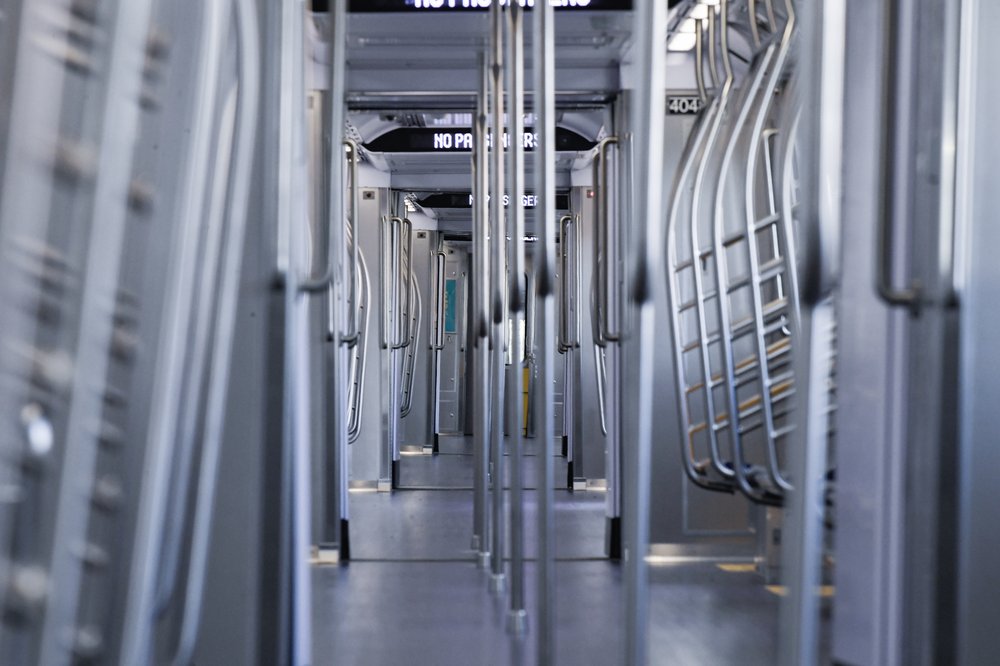MTA's fancy new 'open gangway' subway trains can't run on express tracks, per memo
Jan. 24, 2024, 2:41 p.m.
The directive comes less than three months after a mechanical issue forced the MTA to pull nearly all its new subway cars from service.

The MTA is putting its fancy new “open gangway” subway cars on the slow track.
The new cars have accordion-style connectors that allow riders to walk the train's entire length instead of interior doors. The MTA has been testing the trains for months before putting them into passenger service. They were originally intended to serve the A and C lines, but an internal MTA memo dated Jan. 19 shows the trains are prohibited from carrying passengers while running on the express A line tracks in two key stretches of Brooklyn and Manhattan.
MTA officials initially declined to provide further information. But after publication, Gothamist obtained a second memo, also dated Jan. 19, that provided an explanation: The design of the gangway trains “makes it impossible” for train operators to safely perform a required inspection following the activation of the emergency brakes.
MTA rules require train operators to inspect both sides of the track in the event the emergency brakes are activated. If the operator cannot safely walk both sides of the track – such as when it’s on some express tracks– he or she must climb down in between each car and take a look at the tracks.
That type of inspection is easily done on familiar subway cars, which have doors on each end. But train operators are unable to climb down in between the cars on the new open gangway trains, creating a conflict with MTA safety rules.
The directive is the latest example of the troubled rollout of the MTA's new class of subway trains, known as R211s. The MTA ordered 20 of the open gangway cars — enough for two 10-car trains — in 2018 as part of a $1.44 billion order of 535 new subway cars for the A and C lines.
In 2020, then-NYC Transit executive Frank Jezycki said that the new cars “represent the future of the New York subway and will be the new standard for all new NYC Transit subway cars going forward.”
The accordion-style open trains are used in other subway systems, including the London Underground and Paris Métro, but MTA officials said they wanted to test the concept with a couple of trains before ordering more.
The internal memo directs subway crews to discharge all the passengers aboard a train if it needs to run on the A line express tracks between the Euclid Avenue and Hoyt-Schermerhorn stops or between the 59th Street-Columbus Circle and 125th Street stops.
During a news conference Thursday, NYC Transit President Richard Davey downplayed the significance of the memo, saying the MTA "made a conscious decision" to only run the trains on the local C line.
"You know, for a new car class, we just thought it was more prudent to have that car stopping at stations more frequently," Davey said. "Our A train customers are getting a lot of R211s, so we thought we would give a little love to our C train customers as well."
The MTA has two of the new trains, and Davey said they would start carrying passengers "in the next week or so."

In October, the MTA pulled nearly all of its R211s from service after a mechanical problem caused the wheels to stick, leading them to drag and flatten.
MTA spokesperson Tim Minton said six of those trains were fixed and put back on the tracks, while two remain out of service.
Minton said there is “no operational connection” between the open gangway trains and the issues with the other R211 cars. He said the trains, which are manufactured in Nebraska by the company Kawasaki, have no systemic issues and new ones are still being delivered.
This story has been updated with NYC Transit President Richard Davey's comments on Thursday.
New subway cars still need repairs months after MTA pulled them off rails In Central Brooklyn, a dreaded subway bottleneck grinds trains to a halt MTA’s gleaming new subway cars taken out of service for faulty gearboxes, flat wheels First Look Inside The Coming "Open Gangway" Subway Cars Of The Future